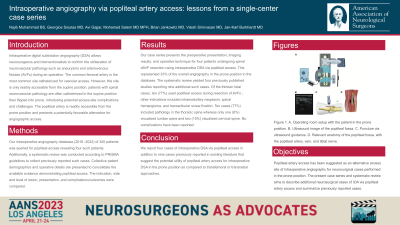Intraoperative angiography via popliteal artery access: lessons from a single-center case series
Intraoperative Angiography via Popliteal Artery Access: Lessons from a Single-center Case Series
Friday, April 21, 2023

- NM
Najib Muhammad, n/a
Medical Student
University of Pennyslvania
ePoster Presenter(s)
Introduction: Intraoperative digital subtraction angiography (DSA) allows neurosurgeons and interventionalists to confirm the obliteration of neurovascular pathology such as aneurysms and arteriovenous fistulas (AVFs) during an operation. The common femoral artery is the most common site catheterized for vascular access. However, this site is only readily accessible from the supine position; patients with spinal neurovascular pathology are often catheterized in the supine position then flipped into prone, introducing potential access-site complications and challenges. The popliteal artery is readily accessible from the prone position and presents a potentially favorable alternative for angiographic access.
Methods: Our intraoperative angiography database (2016 -2022) of 320 patients was queried for popliteal access revealing four such patients. Additionally, a systematic review was conducted according to PRISMA guidelines to collect previously reported such cases. Collective patient demographics and operative details are presented to consolidate the available evidence demonstrating popliteal access. The indication, side and level of lesion, presentation, and complications/outcomes were compared.
Results: Our case series presents the preoperative presentation, imaging results, and operative technique for four patients undergoing spinal dAVF resection using intraoperative DSA via popliteal access. This represented 33% of the overall angiography in the prone position in the database. The systematic review yielded four previously published studies reporting nine additional such cases. Of the thirteen total cases, ten (77%) used popliteal access during resection of AVFs; other indications included intramedullary neoplasm, spinal hemangioma, and transarticular screw fixation. Ten cases (77%) included pathology in the thoracic spine whereas only one (8%) visualized lumbar spine and two (15%) visualized cervical spine. No complications have been reported.
Conclusion : We report four cases of intraoperative DSA via popliteal access in addition to nine cases previously reported in existing literature that suggest the potential utility of popliteal artery access for intraoperative DSA in the prone position as compared to transfemoral or transradial approaches.
Methods: Our intraoperative angiography database (2016 -2022) of 320 patients was queried for popliteal access revealing four such patients. Additionally, a systematic review was conducted according to PRISMA guidelines to collect previously reported such cases. Collective patient demographics and operative details are presented to consolidate the available evidence demonstrating popliteal access. The indication, side and level of lesion, presentation, and complications/outcomes were compared.
Results: Our case series presents the preoperative presentation, imaging results, and operative technique for four patients undergoing spinal dAVF resection using intraoperative DSA via popliteal access. This represented 33% of the overall angiography in the prone position in the database. The systematic review yielded four previously published studies reporting nine additional such cases. Of the thirteen total cases, ten (77%) used popliteal access during resection of AVFs; other indications included intramedullary neoplasm, spinal hemangioma, and transarticular screw fixation. Ten cases (77%) included pathology in the thoracic spine whereas only one (8%) visualized lumbar spine and two (15%) visualized cervical spine. No complications have been reported.
Conclusion : We report four cases of intraoperative DSA via popliteal access in addition to nine cases previously reported in existing literature that suggest the potential utility of popliteal artery access for intraoperative DSA in the prone position as compared to transfemoral or transradial approaches.
